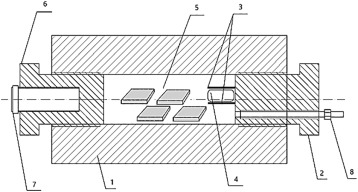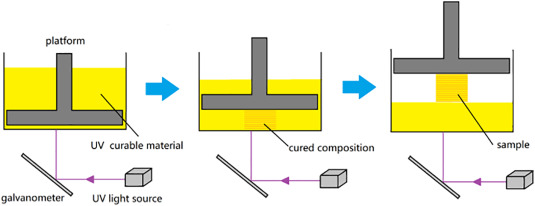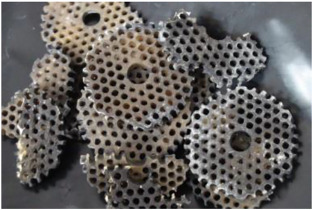Researchers from the Xi’an Modern Chemistry Research Institute in Xi’an China recently 3D printed materials typically used to accelerate thrust of projectiles from guns or other weapons, releasing the details of their study in the recently published “Fabrication and investigation of 3D printed gun propellants.”
Barrel weapons rely on chemicals to propel explosives into the air—and generally toward a target. Acting as the energy source behind artillery, propellants are usually manufactured via traditional methods in cylinders (sometimes perforated) or tubular shapes. Because technology offering better efficiency with high energy release has not been available, the researchers sought a new method to offer greater versatility, power, and potential for customization in materials.
Previously, 3D printing has been used to make both explosives and propellants, from TNT-based explosives to RDX-based microparticles and a variety of composites on the macro- and nano-scale. Selective laser sintering (SLS) and digital light processing (DLP) have been used, while here the researchers chose stereolithography (SLA) for printing of a multi-perforated disk (MPD) propellant charge.
As in many other industries—from automotive to aerospace, medical, and more—the advantages in using 3D printing are plentiful, to include less waste of materials (and in this case, less dangerous residue), better performance, greater efficiency and speed in production, plus savings on the bottom line. Even more important though is the ability to create more complex geometries that simply are not possible with conventional technology.
The authors experimented with a number of different acylates for SLA printing, to include:
- Epoxy acrylate
- Polyester acrylate
- Polyurethane acrylate
- Other modified acrylates
“A series of printing experiments (curability, curing reaction kinetics, viscosity, etc.) had been accomplished to derive the curing compositions and the threshold,” explained the authors. “Here, the epoxy acrylate was adopted for SLA demonstration.”

Compression test with the cylinders before and after a test. (a-before test; b-after test; c-compression process).
Nitramine Bu-NENA was also added as a plasticizer for stable energy content that would not also increase viscosity and cause issues with printing. Fine RDX, featuring a diameter of 25 μm was also used to balance energy and oxygen levels. Closed bomb testing was also required to examine the combustion capabilities of the 3D printed propellant. Ultimately, the materials were put to the real test in firing a gun.

Schematic of closed bomb. 1-vessel; 2, 6-end cap; 3-wire; 4-ignition bag with NC powder; 5-test sample; 7-pressure gage.
In testing the multi-perforated disk (MPD) propellant, the researchers found no defects in the SLA-printed materials, noting compression strength at 21.6 MPa and tensile strength at 7.3 MPa. A desired muzzle velocity of 420 m/s was used, and did not harm the MPD; however, residue samples indicated that all of the MPD propellants did not burn thoroughly.
As the researchers continue experimenting and optimizing the propellant further, they plan to add pressure to the gun chamber slowly, evaluating the strength of the propellant in vented bomb tests.
3D printing has been associated with weapons, bullets, and more in the past few years—often with great controversy. While gangsters have been busted with guns and associated 3D printing hardware and famed bad-boy mavericks like Cody Wilson have been hung up in the legal system regarding the right to release gun designs for 3D printing publicly, the fact remains that a trend in violence or shootings stemming from the technology has yet to be seen. Studies such as experimenting with better propellants could offer positive impact to major manufacturers, however, as well as other organizations like the military.
[Source / Images: ‘Fabrication and investigation of 3D printed gun propellants’]
Subscribe to Our Email Newsletter
Stay up-to-date on all the latest news from the 3D printing industry and receive information and offers from third party vendors.
You May Also Like
New Report: Semiconductor Industry to See $1.4B in 3D Printing Revenues by 2032
“The semiconductor sector has become the most strategically significant area of global industry.” Truer words are hard to come by when it comes to the modern world, and they are...
Will Photonic-Crystal Lasers Revolutionize 3D Printing?
Powder bed fusion (PBF) for metals and polymers predominantly utilizes lasers as the primary heat source. Some directed energy deposition (DED) technologies also employ lasers, while various vat polymerization methods...
3D Printing Unpeeled: Orbex Investment, IndoMIM and HP, Ultrasonic Waves
INDO-MIM has bought three HP Metal Jet S100 printers, operating two in India and one in Texas. This is a win for HP because the company has deep experience in...
3D Printing Webinar and Event Roundup: April 21, 2024
It’s another busy week of webinars and events, starting with Hannover Messe in Germany and continuing with Metalcasting Congress, Chinaplas, TechBlick’s Innovation Festival, and more. Stratasys continues its advanced training...


































